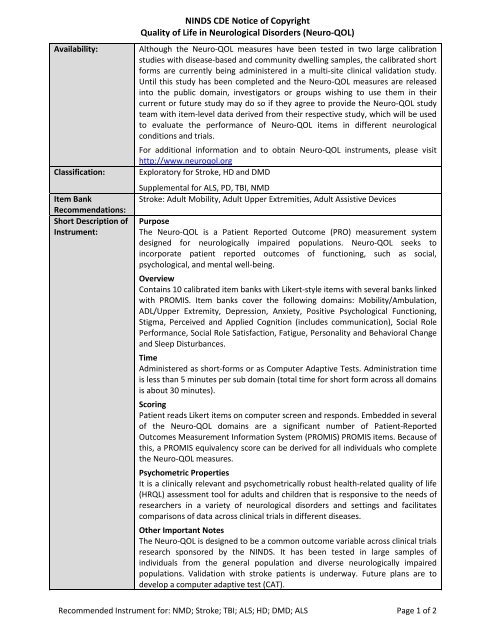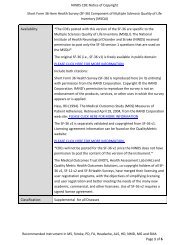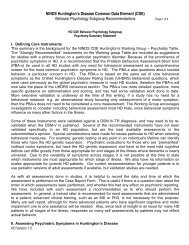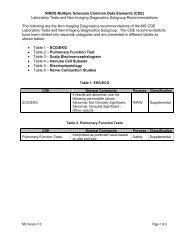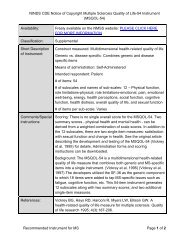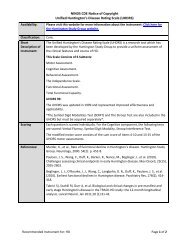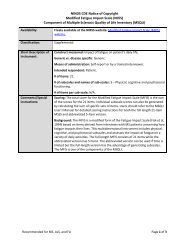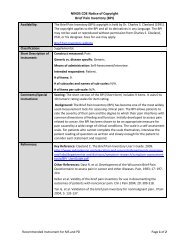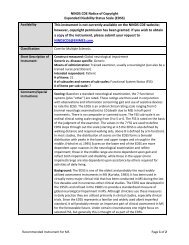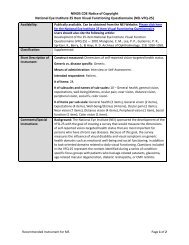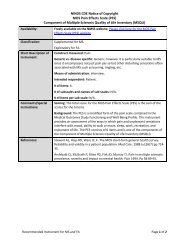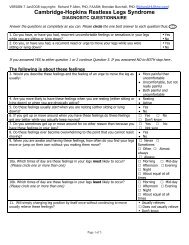NOC - NINDS Common Data Elements
NOC - NINDS Common Data Elements
NOC - NINDS Common Data Elements
You also want an ePaper? Increase the reach of your titles
YUMPU automatically turns print PDFs into web optimized ePapers that Google loves.
Availability:Classification:Item BankRecommendations:Short Description ofInstrument:<strong>NINDS</strong> CDE Notice of CopyrightQuality of Life in Neurological Disorders (Neuro-QOL)Although the Neuro-QOL measures have been tested in two large calibrationstudies with disease-based and community dwelling samples, the calibrated shortforms are currently being administered in a multi-site clinical validation study.Until this study has been completed and the Neuro-QOL measures are releasedinto the public domain, investigators or groups wishing to use them in theircurrent or future study may do so if they agree to provide the Neuro-QOL studyteam with item-level data derived from their respective study, which will be usedto evaluate the performance of Neuro-QOL items in different neurologicalconditions and trials.For additional information and to obtain Neuro-QOL instruments, please visithttp://www.neuroqol.orgExploratory for Stroke, HD and DMDSupplemental for ALS, PD, TBI, NMDStroke: Adult Mobility, Adult Upper Extremities, Adult Assistive DevicesPurposeThe Neuro-QOL is a Patient Reported Outcome (PRO) measurement systemdesigned for neurologically impaired populations. Neuro-QOL seeks toincorporate patient reported outcomes of functioning, such as social,psychological, and mental well-being.OverviewContains 10 calibrated item banks with Likert-style items with several banks linkedwith PROMIS. Item banks cover the following domains: Mobility/Ambulation,ADL/Upper Extremity, Depression, Anxiety, Positive Psychological Functioning,Stigma, Perceived and Applied Cognition (includes communication), Social RolePerformance, Social Role Satisfaction, Fatigue, Personality and Behavioral Changeand Sleep Disturbances.TimeAdministered as short-forms or as Computer Adaptive Tests. Administration timeis less than 5 minutes per sub domain (total time for short form across all domainsis about 30 minutes).ScoringPatient reads Likert items on computer screen and responds. Embedded in severalof the Neuro-QOL domains are a significant number of Patient-ReportedOutcomes Measurement Information System (PROMIS) PROMIS items. Because ofthis, a PROMIS equivalency score can be derived for all individuals who completethe Neuro-QOL measures.Psychometric PropertiesIt is a clinically relevant and psychometrically robust health-related quality of life(HRQL) assessment tool for adults and children that is responsive to the needs ofresearchers in a variety of neurological disorders and settings and facilitatescomparisons of data across clinical trials in different diseases.Other Important NotesThe Neuro-QOL is designed to be a common outcome variable across clinical trialsresearch sponsored by the <strong>NINDS</strong>. It has been tested in large samples ofindividuals from the general population and diverse neurologically impairedpopulations. Validation with stroke patients is underway. Future plans are todevelop a computer adaptive test (CAT).Recommended Instrument for: NMD; Stroke; TBI; ALS; HD; DMD; ALS Page 1 of 2
References:<strong>NINDS</strong> CDE Notice of CopyrightQuality of Life in Neurological Disorders (Neuro-QOL)TBI CDE Working Group (2010). CDE Recommendations - Listing of the Core,Supplemental and Emerging Measures for each Outcome Domain.http://www.commondataelements.ninds.nih.gov/TBI.aspx (accessed March 10,2010).Neuro-QOL Bank Development and Construction. http://www.neuroqol.org(accessed March 10, 2010).HD:Cella, D., Nowinski, C., Peterman, A., Victorson, D., Miller, D., Lai, J.-S., & Moy, C.(2011). The Neurology Quality of Life Measurement (Neuro-QOL) Initiative.Archives of Physical Medicine and Rehabilitation, Supplement, 92(Suppl 1), S28-S36. doi: 10.1016/j.apmr.2011.01.025 Carlozzi, N. E. (2010, October), ExaminingHealth-Related Quality of Life in Huntington’s Disease. In A. W. Heinemann(Chair), Advances in Outcome Measures for Neurologic Disorders. Symposiapresented at the ACRM-ASNR Joint Educational Conference, Montreal, Quebec,Canada.Carlozzi, N. E., & Tulsky, D. S. (2011, September). Health-related quality of life inHuntington disease. Published Abstract from the Huntington’s Disease WorldCongress 2011, Melbourne, Australia. Clinical Genetics, 80 (Suppl 1), 37-38.Carlozzi, N. E., McGowan, H., & Tulsky, D. S. (2010, October). Extending theNeuro-QOL to Huntington’s Disease (HD): The development of the HD-HRQOL.Poster presented at the International Society for Quality of Life Research 17thAnnual Conference, London, England.Carlozzi, N. E., & Ready, R. E. (2011). Health-Related Quality of Life inHuntington’s Disease. In C. Jenkinson, M. Peters, & M. B. Bromberg (Eds.), Qualityof Life and Neurodegenerative Disease (pp 71-81), Cambridge, UK, CambridgeUniversity Press.Carlozzi, N. E. (2012, February). Adaptations of the PROMIS and Neuro-QOL totraumatic brain injury (TBI) and Huntington disease (HD). In D. S. Tulsky & N. E.Carlozzi (Co-Chairs), <strong>Common</strong> data elements in neurological research. Symposiasubmitted for presentation at the 40th Annual International NeuropsychologicalSociety Meeting, Montreal, Canada.Carlozzi, N. E., & Tulsky, D.S. Identification of Health-Related Quality of Life(HRQOL) Issues Relevant to Individuals with HD (In Press). The Journal of HealthPsychology.Recommended Instrument for: NMD; Stroke; TBI; ALS; HD; DMD; ALS Page 2 of 2


